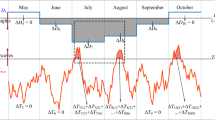Abstract
Stable light data from Defense Meteorological Satellite Program (DMSP)/Operational Linescan System (OLS) satellites and authoritative energy consumption data distributed by National Bureau of Statistics of China were applied to estimating the distribution of anthropogenic heat release in China from 1992 to 2009. A strong linear relationship was found between DMSP/OLS digital number data and anthropogenic heat flux density (AHFD). The results indicate that anthropogenic heat release in China was geographically concentrated and was fundamentally correlated with economic activities. The anthropogenic heat release in economically developed areas in northern, eastern, and southern China was much larger than other regions, whereas it was very small in northwestern and southwestern China. The mean AHFD in China increased from 0.07 W m−2 in 1978 to 0.28 W m−2 in 2008. The results indicate that in the anthropogenic heat-concentrated regions of Beijing, the Yangtze River Delta, and the Pearl River Delta, the AHFD levels were much higher than the average. The effect of aggravating anthropogenic heat release on climate change deserves further investigation.
Similar content being viewed by others
References
Amaral, S., A. M. V. Monteiro, G. Camara, et al., 2006: DMSP/OLS night-time imagery for urban population estimates in Brazilian Amazon. Int. J. Remote Sensing, 27, 855–870.
Block, A., K. Keuler, and E. Schaller, 2004: Impacts of anthropogenic heat on regional climate patterns. Geophys. Res. Lett., 31, L12211, doi: 10.1029/2004GL019852.
Cinzano, P., F. Falchi, and C. D. Elvidge, 2001: The first world atlas of the artificial night sky brightness. Mon. Notices Roy. Astron. Soc., 328(3), 689–707.
Doll, C. N. H., J.-P. Muller, and C. D. Elvidge, 2000: Night-time imagery as a tool for global mapping of socio-economic parameters and greenhouse gas emissions. Ambio, 29(3), 157–162.
Elvidge, C. D., K. E. Baugh, E. A. Kihn, et al., 1997a: Mapping city lights with nighttime data from the DMSP operational linescan system. Photogrammetric Engineering and Remote Sensing, 63(6), 727–734.
—, —, —, et al., 1997b: Relation between satellite observed visible-near infrared emissions, population, economic activity and electric power consumption. Int. J. Remote Sensing, 18, 1373–1379.
Fan, H., and D. J. Sailor, 2005: Modeling the impacts of anthropogenic heating on the urban climate of Philadelphia: A comparison of implementations in two PBL schemes. Atmos. Environ., 39, 73–84.
Hamilton, I. G., M. Davies, P. Steadman, et al., 2009: The significance of the anthropogenic heat emissions of London’s buildings: A comparison against captured shortwave solar radiation. Building and Environment, 44, 807–817.
Husi, L., H. Masanao, Y. Hiroshi, et al., 2010: Estimating energy consumption from night-time DMSP/OLS imagery after correcting for saturation effects. Int. J. Remote Sensing, 31, 4443–4458.
Ichinose, T., K. Shimodozono, and K. Hanaki, 1999: Impact of anthropogenic heat on urban climate in Tokyo. Atmos. Environ., 33, 3897–3909.
IPCC, 2007: Climate Change 2007: The Physical Science Basis, Contribution of Working Group I to the Fourth Assessment Report of the Intergovernmental Panel on Climate Change. Solomon S., D. Qin, et al., Eds., Cambridge University Press, Cambridge, United Kingdom and New York, NY, USA, 996 pp.
Lee, S. H., C. K. Song, J. J. Baik, et al., 2009: Estimation of anthropogenic heat emission in the Gyeong-In region of Korea, Theor. Appl. Climatol., 96, 291–303.
Makar, P. A., S. Gravel, V. Chirkov, et al., 2006: Heat flux, urban properties, and regional weather. Atmos. Environ., 40, 2750–2766.
National Bureau of Statistics of China, 2010a: China Energy Statistical Yearbook 2009. China Statistics Press, Beijing, 536 pp. (in Chinese)
—, 2010b: China Statistical Yearbook 2010. China Statistics Press, Beijing, 1072 pp. (in Chinese)
Oke, T. R., 1988: The urban energy balance. Progerss in Physical Geography, 12, 471–580.
Oleson, K.W., G. B. Bonan, J. Fedema, et al., 2011: An examination of urban heat island characteristics in a global climate model. Int. J. Climatol., 31(12), 1848–1865.
Small, C., P. Francesca, and C. D. Elvidge, 2005: Spatial analysis of global urban extent from DMSP-OLS night lights. Remote Sensing Environ., 96, 277–291.
Tilottama, G., A. Sharolyn, L. P. Rebecca, et al., 2009: Estimation of Mexico’s informal economy and remittances using nighttime imagery. Remote Sens., 1, 418–444.
Tong Hua, Liu Zhihua, Sang Jianguo, et al., 2004: The impact of urban anthropogenic heat on the Beijing heat environment. Climatic Environ. Res., 9(3), 410–421. (in Chinese)
Author information
Authors and Affiliations
Corresponding author
Additional information
Supported by the National Natural Science Foundation of China (40775008 and 41075015) and Ministry of Science and Technology of China (2010DFA22770).
Rights and permissions
About this article
Cite this article
Chen, B., Shi, G., Wang, B. et al. Estimation of the anthropogenic heat release distribution in China from 1992 to 2009. Acta Meteorol Sin 26, 507–515 (2012). https://doi.org/10.1007/s13351-012-0409-y
Received:
Accepted:
Published:
Issue Date:
DOI: https://doi.org/10.1007/s13351-012-0409-y




